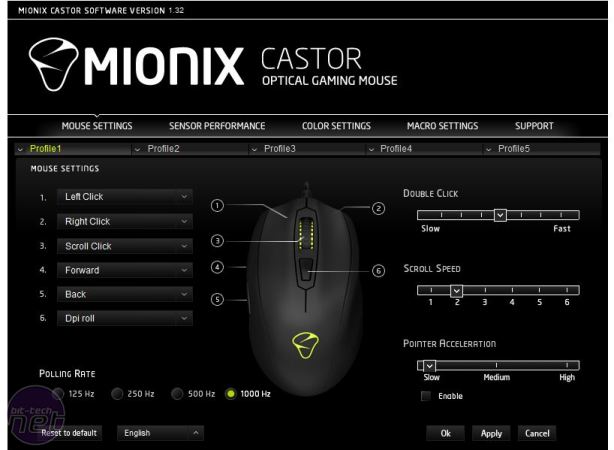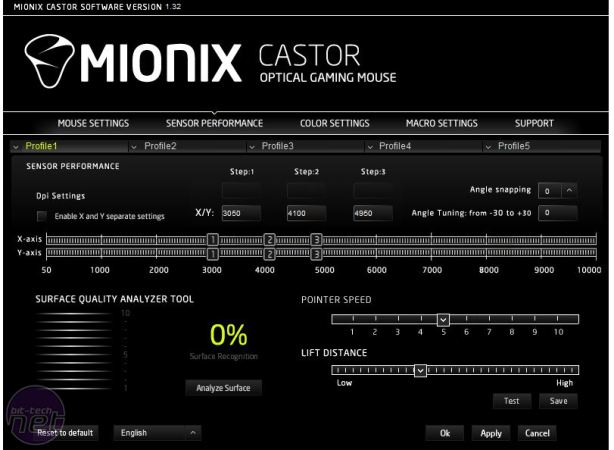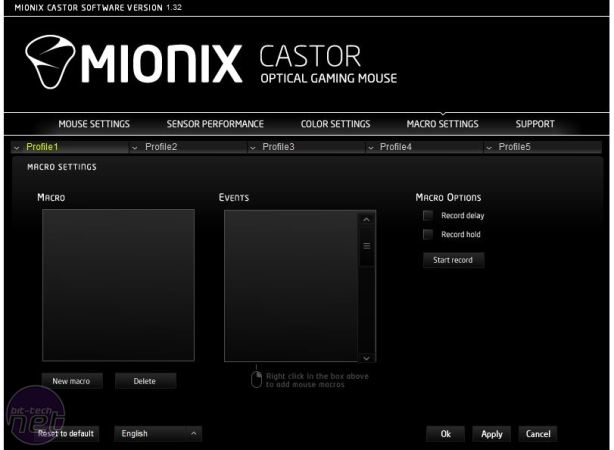
More importantly they can each acquire their own colours too, so at least there is one, albeit slightly haphazard way of getting an at-a-glance look at which sensitivity you're currently at. The down size is that you'll have to use one of the six buttons to act as a profile toggle.
There are a few other useful features in the software too, such as lift distance, pointer speed, USB polling rate, angle snapping and angle tuning adjustment, the ability to separate X and Y axis sensitivity, pointer acceleration and the ability to reprogram each of the six buttons.
Lighting control is fairly extensive, but again, we'd rather have a DPI colour indicator than the ability to have RGB lighting and pulsating or breathing effects. Another feature in the software is the ability to record macros plus there's Mionix's Surface Quality Analyzer Tool too, although this is more advice on the surface quality than actively compensating for a dodgy mousemat.
The optical sensor is a PixArt PMW 3310 - similar to that in the Asus ROG Sica, which as we've already said, offers up to 10,000DPI sensitivity and sports a tracking speed of 5.45m/sec (215 IPS).
As we found with the Asus mouse, it's a fantastic sensor that offers smooth, predictable and acceleration and jitter-free tracking. The Castor is certainly a mouse that you can pick up and use to a high level within minutes of opening the box, requiring very little time to get used to - a testament to the sensor and ergonomics. The soft-touch rubber coating does an excellent job of keeping moisture away from your skin so even after long gaming sessions it was still pleasant to use.
Conclusion
The Castor is certainly very flexible, with its design loaning itself to a range of gamer types from FPS to RTS and MOBA alike. It's light, comfortable, sports the usual Mionix feel and offers a good deal of tweakable settings and is very solid-feeling - certainly enough to live up to its price tag. However, it falls short of earning an award because that price is just a tad too high considering the limited features.
Mice such as the similar-sized and priced Corsair Gaming M65 RGB offer a more advanced set of buttons including up and down DPI toggle switches as well as a sniper mode button, with more DPI settings configurable in the software compared to the Castor too. You also get DPI level lighting - something we often felt was missing. The £60 price bracket for gaming mice is a crowded one that's filled with many excellent examples, including Mionix's own Naos 8200. Ultimately the Castor is far from bad - in fact it's very good and if you just need a small, simple, high quality, tweakable mouse it should definitely be on your shortlist. However, in more general terms we feel it needs to add a bit more pizazz to the equation to justify its price.
Click to enlarge
There are a few other useful features in the software too, such as lift distance, pointer speed, USB polling rate, angle snapping and angle tuning adjustment, the ability to separate X and Y axis sensitivity, pointer acceleration and the ability to reprogram each of the six buttons.
Click to enlarge
Lighting control is fairly extensive, but again, we'd rather have a DPI colour indicator than the ability to have RGB lighting and pulsating or breathing effects. Another feature in the software is the ability to record macros plus there's Mionix's Surface Quality Analyzer Tool too, although this is more advice on the surface quality than actively compensating for a dodgy mousemat.
Click to enlarge
The optical sensor is a PixArt PMW 3310 - similar to that in the Asus ROG Sica, which as we've already said, offers up to 10,000DPI sensitivity and sports a tracking speed of 5.45m/sec (215 IPS).
Click to enlarge
As we found with the Asus mouse, it's a fantastic sensor that offers smooth, predictable and acceleration and jitter-free tracking. The Castor is certainly a mouse that you can pick up and use to a high level within minutes of opening the box, requiring very little time to get used to - a testament to the sensor and ergonomics. The soft-touch rubber coating does an excellent job of keeping moisture away from your skin so even after long gaming sessions it was still pleasant to use.
Click to enlarge
Conclusion
The Castor is certainly very flexible, with its design loaning itself to a range of gamer types from FPS to RTS and MOBA alike. It's light, comfortable, sports the usual Mionix feel and offers a good deal of tweakable settings and is very solid-feeling - certainly enough to live up to its price tag. However, it falls short of earning an award because that price is just a tad too high considering the limited features.
Mice such as the similar-sized and priced Corsair Gaming M65 RGB offer a more advanced set of buttons including up and down DPI toggle switches as well as a sniper mode button, with more DPI settings configurable in the software compared to the Castor too. You also get DPI level lighting - something we often felt was missing. The £60 price bracket for gaming mice is a crowded one that's filled with many excellent examples, including Mionix's own Naos 8200. Ultimately the Castor is far from bad - in fact it's very good and if you just need a small, simple, high quality, tweakable mouse it should definitely be on your shortlist. However, in more general terms we feel it needs to add a bit more pizazz to the equation to justify its price.
-
Features27 / 35
-
Design36 / 40
-
Value19 / 25


MSI MPG Velox 100R Chassis Review
October 14 2021 | 15:04













Want to comment? Please log in.